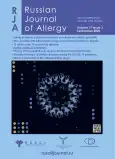Biological therapy of allergic diseases during the COVID-19 pandemic
- Authors: Fedenko E.S.1, Elisyutina O.G.1, Il`ina N.I.1
-
Affiliations:
- NRCI Institute of Immunology FMBA of Russia
- Issue: Vol 17, No 3 (2020)
- Pages: 115-120
- Section: Help to the practitioner
- URL: https://journals.rcsi.science/raj/article/view/121684
- DOI: https://doi.org/10.36691/RJA1382
- ID: 121684
Cite item
Full Text
Abstract
The outbreak of the SARS-CoV-2-induced Coronavirus Disease 2019 (COVID-19) pandemic started in December 2019 in Wuhan, China, continued to spread across the globe and spanned 188 countries. Under the new circumstances treatment approach for T2 allergic diseases such as asthma, chronic hives, atopic dermatitis, and sinusitis with polyps has been changed. In the past years, new biological therapies – monoclonal antibodies for these diseases have been developed targeting different aspects of the type 2 immune response. New knowledge on the COVID-19 disease course raises many issues around the safety of biologicals in patients with active infection, as well as their interactions with antiviral medications. In Russia new biological therapies entered clinical practice but it’s effectiveness and safety still are not known.
This newsletter is based on “Considerations on Biologicals for Patients with allergic disease in times of the COVID-19 pandemic: an EAACI Statement” and the latest scientific data.
Full Text
##article.viewOnOriginalSite##About the authors
Elena S. Fedenko
NRCI Institute of Immunology FMBA of Russia
Author for correspondence.
Email: efedks@gmail.com
ORCID iD: 0000-0003-3358-5087
head of Skin Allergy and Immunopathology Department, NRC Institute of Immunology FMBA of Russia, MD, PhD, professor
Russian Federation, MoscowOlga G. Elisyutina
NRCI Institute of Immunology FMBA of Russia
Email: el-olga@yandex.ru
ORCID iD: 0000-0002-4609-2591
leading researcher of Skin Allergy and Immunopathology Department, NRC Institute of Immunology FMBA of Russia, MD, PhD
Russian Federation, MoscowNatalia I. Il`ina
NRCI Institute of Immunology FMBA of Russia
Email: instimmun@yandex.ru
ORCID iD: 0000-0002-3556-969X
head physician, NRC Institute of Immunology FMBA of Russia, MD, PhD, professor
Russian Federation, MoscowReferences
- Zhu N, Zhang D, Wang W, Li X, Yang B, Song J, et al. A novel coronavirus from patients with pneumonia in China, 2019. N Engl J Med. 2020;382(8):727–733. doi: 10.1056/NEJMoa2001017
- Azkur AK, Akdis M, Azkur D, Sokolowska M, van de Veen W, Brüggen MC, et al. Immune response to SARS-CoV-2 and mechanisms of immunopathological changes in COVID-19. Allergy. 2020;75(7):1564–1581. doi: 10.1111/all.14364
- ecdc.europa.eu [Internet]. European Centre for Disease Prevention and Control. Rapid risk assessment: Coronavirus disease 2019 (COVID-19) pandemic: increased transmission in the EU/EEA and the UK – seventh update [cited 2020 Jul 23]. Available from: https://www.ecdc.europa.eu/en/publications-data/rapid-risk-assessment-coronavirus-disease-2019-covid-19-pandemic
- Maggi E, Canonica GW, Moretta L. COVID-19: unanswered questions on immune response and pathogenesis. J Allergy Clin Immunol. 2020;146(1):18–22. doi: 10.1016/j.jaci.2020.05.00
- Rothan HA, Byrareddy SN. The epidemiology and pathogenesis of coronavirus disease (COVID-19) outbreak. J Autoimmun. 2020;109:102433. doi: 10.1016/j.jaut.2020.102433
- Lommatzsch M, Stoll P, Virchow JC. COVID-19 in a patient with severe asthma treated with Omalizumab. Allergy. 2020;10.1111/all.14456. doi: 10.1111/all.14456
- Gill MA, Liu AH, Calatroni A, Krouse RZ, Shao B, et al. Enhanced plasmacytoid dendritic cell antiviral responses after omalizumab. J Allergy Clin Immunol. 2018;141(5):1735–1743. doi: 10.1016/j.jaci.2017.07.035
- Teach SJ, Gill MA, Togias A, Sorkness CA, Arbes SJ Jr, Calatroni A, et al. Preseasonal treatment with either omalizumab or an inhaled corticosteroid boost to prevent fall asthma exacerbations. J Allergy Clin Immunol. 2015;136(6):1476–1485. doi: 10.1016/j.jaci.2015.09.008
- Esquivel A, Busse WW, Calatroni A, Togias AG, Grindle KG, Bochkov YA, et al. Effects of omalizumab on rhinovirus infections, illnesses, and exacerbations of asthma. Am J Respir Crit Care Med. 2017;196(8):985–992. doi: 10.1164/rccm.201701-0120OC
- Busse WW, Morgan WJ, Gergen PJ, Mitchell HE, Gern JE, Liu AH, et al. Randomized trial of omalizumab (anti-IgE) for asthma in inner-city children. N Engl J Med. 2011;364(11):1005–1015.
- Caroppo F, Biolo G, Belloni Fortina A. SARS-CoV-2 asymptomatic infection in a patient under treatment with dupilumab. J Eur Acad Dermatol Venereol. 2020;34(8):e368. doi: 10.1111/jdv.16619
- Wollenberg A, Flohr C, Simon D, Cork MJ, Thyssen JP, Bieber T, et al. European Task Force on Atopic Dermatitis (ETFAD) statement on severe acute respiratory syndrome coronavirus 2 (SARS-Cov-2)-infection and atopic dermatitis. J Eur Acad Dermatol Venereol. 2020;34(6):e241–e242. doi: 10.1111/jdv.16411
- Vultaggio A, Agache I, Akdis CA, Akdis M, Bavbek S, Bossios A, et al. Considerations on biologicals for patients with allergic disease in times of the COVID-19 pandemic: an EAACI Statement. Allergy. 2020;10.1111/all.14407. doi: 10.1111/all.14407
- Jackson DJ, Busse WW, Bacharier LB, Kattan M, O’Connor GT, Wood RA, et al. Association of respiratory allergy, asthma and expression of the SARS-CoV-2 Receptor, ACE2. J Allergy Clin Immunol. 2020;146(1):203–206.e3. doi: 10.1016/j.jaci.2020.04.009
- Peters MC, Sajuthi S, Deford P, Christenson S, Rios CL, Montgomery MT, et al. COVID-19 related genes in sputum cells in asthma: relationship to demographic features and corticosteroids. Am J Respir Crit Care Med. 2020;202(1):83–90. doi: 10.1164/rccm.202003-0821OC
- Grasselli G, Zangrillo A, Zanella A, Antonelli M, Cabrini L, Castelli A, et al. Baseline characteristics and outcomes of 1591 patients infected with SARS-CoV-2 admitted to ICUs of the Lombardy Region, Italy. JAMA. 2020;323(16):1574–1581. doi: 10.1001/jama.2020.5394
Supplementary files







